
A | B | C | D | E | F | G | H | CH | I | J | K | L | M | N | O | P | Q | R | S | T | U | V | W | X | Y | Z | 0 | 1 | 2 | 3 | 4 | 5 | 6 | 7 | 8 | 9

This is a list of fermented foods, which are foods produced or preserved by the action of microorganisms. In this context, fermentation typically refers to the fermentation of sugar to alcohol using yeast, but other fermentation processes involve the use of bacteria such as lactobacillus, including the making of foods such as yogurt and sauerkraut. Many fermented foods are mass-produced using industrial fermentation processes. The science of fermentation is known as zymology.
Many pickled or soured foods are fermented as part of the pickling or souring process, but many are simply processed with brine, vinegar, or another acid such as lemon juice.
Fermented foods
Fermented beans and seeds
| Name | Image | Origin | Description |
|---|---|---|---|
| Cocoa | 
|
Mesoamerica | Cocoa bean fermentation for chocolate, and other cocoa products. |
| Cheonggukjang | 
|
Korea | A fermented soybean paste used in Korean cuisine that contains both whole and ground soybeans. |
| Doenjang | 
|
Korea | A thick bean paste that includes fermentation in its preparation. |
| Doubanjiang | 
|
China | A spicy, salty paste made from fermented broad beans, soybeans, salt, rice, and various spices. |
| Douchi | 
|
China | A type of fermented and salted black soybean. |
| Douzhi | 
|
Beijing | This is a fermented dish from Beijing cuisine. It is similar to soy milk, but made from mung beans. It is a by-product of cellophane noodle production. It is generally slightly sour, with an egg-like smell. (Pictured in bowl at bottom left.) |
| Fermented bean curd | 
|
China | Fermented tofu. |
| Fermented bean paste | 
|
East Asia | A category of fermented foods typically made from ground soybeans, which are indigenous to the cuisines of East and Southeast Asia. In some cases, such as in the production of miso, other varieties of beans such as broad beans may also be used.[1] |
| Lufu | China | A type of fermented bean curd. | |
| Miso | 
|
Japan | A bean paste that includes fermentation in its preparation. |
| Nattō | 
|
Japan | Nattō (なっとう or 納豆) is a traditional Japanese food made from soybeans fermented with Bacillus subtilis var. natto. Some eat it as a breakfast food. It is served with soy sauce, karashi mustard and Japanese bunching onion. Nattō may be an acquired taste because of its powerful smell, strong flavor, and slimy texture. In Japan, nattō is most popular in the eastern regions, including Kantō, Tōhoku, and Hokkaido. |
| Ogiri | West Africa | A flavoring made of fermented oil seeds, such as sesame seeds or egusi seeds. The process and product are similar to iru or douchi. Its smell is like cheese, miso, or stinky tofu. | |
| Oncom | 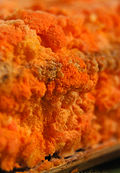
|
West Java, Indonesia | A traditional staple food closely related to tempeh, usually made from various byproducts of other foods such as tofu. Red and black oncom are made using different varieties of mold. |
| Pon ye gyi | 
|
Myanmar (Burma) | A fermented bean paste commonly used as a condiment or marinade, traditionally made from horse gram beans, alongside other beans. |
| Ssamjang | 
|
Korea | A thick, spicy paste used with food wrapped in a leaf in Korean cuisine. The sauce is made of fermented soy beans (doenjang), red chili paste (gochujang), sesame oil, onion, garlic, green onions, and optionally brown sugar. |
| Stinky tofu (chòu dòufu) | 
|
China, Hong Kong, Taiwan | A variety of fermented tofu. |
| Tempeh | 
|
Indonesia | A traditional soy product originally from Indonesia that is made by a natural culturing and controlled fermentation process that binds soybeans into a cake form. |
| Tianmianjiang | 
|
China | A thick, smooth, dark brown or black paste with either a mild, savory or sweet flavor, also known as sweet bean sauce, sweet flour sauce or sweet wheat paste. Peking duck and jajangmyeon (black bean noodles) are two popular dishes that feature the sauce. |
| Tương | Vietnam | Originally, the term tương referred to a salty paste made from fermented soybeans. The word tương can also be used to refer to other condiments, such as tương cà (tomato sauce), tương xí muội (plum sauce) or tương ớt (chilli sauce). In southern Vietnam, nước tương refers to soy sauce while Northern Vietnam calls it xì dầu. | |
| Tungrymbai | Meghalaya, India | A fermented soybean food. Tungrymbai is usually prepared by crushing the fermented beans until it almost becomes a paste, and frying in mustard oil with onion-ginger-garlic paste, black sesame seed paste, aromatics and pork. | |
| Yellow soybean paste (huáng jiàng) | Northern China | A fermented paste made from yellow soybeans, salt, and water. |
Fermented cheeses
Most cheeses are fermented as part of their production.
| Name | Image | Origin | Description |
|---|---|---|---|
| Ambra di Talamello | |||
| Limburger | 
|
||
| Tvorog | 
|
Russia | A white cheese originating in Russia |
| Shanklish | 
|
Fermented condiments
| Name | Image | Origin | Description |
|---|---|---|---|
| Bagoong | 
|
Philippines | A Philippine condiment made of partially or completely fermented fish or shrimp and salt.[2] The fermentation process also results in fish sauce (known as patis).[3] |
| Dayok | Philippines | A type of fish sauce originating from the Visayas and Mindanao islands of the Philippines made from fermented yellowfin tuna entrails. | |
| Fish sauce | 
|
East and Southeast Asia | A liquid condiment made from fish or krill that have been coated in salt and fermented for up to two years. It is used as a staple seasoning in East Asian cuisine and Southeast Asian cuisine. Some garum-related fish sauces have been used in the West since the Roman times. |
| Ganjang | 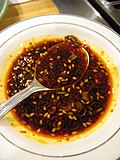
|
Korea | A kind of Korean soy sauce made from fermented soybeans. Ganjang is a uniquely Korean condiment. |
| Garum | Ancient Rome | Garum was a fish sauce made from the fermentation of fish entrails, used as a condiment in the cuisines of ancient Greece, Rome, and Byzantium. It is believed to have resembled the fermented anchovy sauce colatura di alici still produced today in Campania, Italy. | |
| Gochujang | 
|
Korea | A savory, sweet, and spicy fermented condiment popular in Korean cooking. It is made from gochu-garu (chili powder), glutinous rice, meju (fermented soybean) powder, yeotgireum (barley malt powder), and salt. |
| Iru | 
|
Nigeria | A type of fermented and processed locust beans (Parkia biglobosa) used as a condiment in cooking, very popular among the Yoruba people and Edo people of Nigeria. |
| Murri (condiment) | Middle East | A type of fermented condiment made with barley flour, comparable to soy sauce. | |
| Soy sauce | 
|
Korea, Japan, China, Taiwan, Philippines, Indonesia | Pictured is traditional Korean soy sauce. |
| Sumbala | 
|
West Africa | A fermented seed condiment, traditionally prepared from néré (Parkia biglobosa) seeds, but also from other kinds of seeds, such as those of Prosopis africana, and, nowadays, soybeans. It is comparable to miso paste. |
| Vinegar | 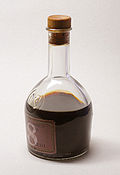
|
An aqueous solution of acetic acid and trace compounds that may include flavorings. Usually, the acetic acid is produced by a double fermentation, converting simple sugars to ethanol using yeast, and ethanol to acetic acid by acetic acid bacteria. It is now mainly used in the culinary arts as a flavorful, acidic cooking ingredient, or in pickling. Various types of vinegar are also used as condiments or garnishes, including balsamic vinegar and malt vinegar. As the most easily manufactured mild acid, it has a wide variety of industrial and domestic uses, including use as a household cleaner. | |
| Worcestershire sauce | 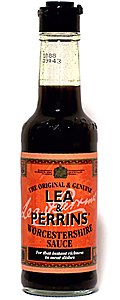
|
Worcestershire, England | A fermented liquid condiment named after the city of Worcester in Worcestershire, England. It is frequently used to augment food and drink recipes, and used directly as a condiment on steaks, hamburgers, and other finished dishes. |
| Yongfeng chili sauce | 
|
Yongfeng, Shuangfeng County, Loudi city, Hunan province, China | Fermented hot sauce from Hunan. |
Fermented creams and yogurts
| Name | Image | Origin | Description |
|---|---|---|---|
| Amasi | 
|
South Africa | A type of fermented milk that tastes like cottage cheese or plain yogurt. |
| Crème fraîche | 
|
France | A soured cream containing 30–45% butterfat and having a pH of around 4.5.[4] It is soured with bacterial culture, but is less sour than U.S.-style sour cream, and has a lower viscosity and a higher fat content. |
| Fermented milk products | Worldwide | Also known as cultured dairy foods, cultured dairy products, or cultured milk products, fermented milk products are dairy foods that have been fermented with lactic acid bacteria such as Lactobacillus, Lactococcus, and Leuconostoc. | |
| Filmjölk | 
|
Nordic countries | A mesophilic fermented milk product that is made by fermenting cow's milk with a variety of bacteria from the species Lactococcus lactis and Leuconostoc mesenteroides.[5][6] |
| Kaymak | 
|
Central Asia | A fermented, creamy dairy food similar to clotted cream, made from the milk of water buffalo, cows, sheep, or goats. |
| Matzoon | Armenia | A fermented milk product of Armenian origin. | |
| Mursik | Kenya | A traditional fermented milk variant of the Kalenjin people of Kenya. It can be made from cow or goat milk and is fermented in a specially made calabash gourd locally known as a sotet. The gourd is lined with soot from specific trees which add flavor to the fermented milk. | |
| Skyr | 
|
Iceland | A cultured dairy product, with the consistency of strained yogurt, but a milder flavor. Skyr can be classified as a fresh sour milk cheese (similar to curd cheese eaten in Estonia, Germany and Russia), but is consumed like a yogurt. |
| Smetana, Smântână | 
|
Central and Eastern Europe | A type of sour cream, produced by souring heavy cream. It is similar to crème fraîche. |
| Sour cream | 
|
Obtained by fermenting a regular cream with certain kinds of lactic acid bacteria.[7] The bacterial culture, which is introduced either deliberately or naturally, sours and thickens the cream. Pictured is Smetana. | |
| Soured milk | 
|
Soured milk denotes a range of food products produced by the acidification of milk. Soured milk that is produced by bacterial fermentation is more specifically called fermented milk or cultured milk. Soured milk that is produced by the addition of an acid, with or without the addition of microbial organisms, is more specifically called acidified milk. | |
| Strained yogurt | 
|
Strained yogurt, Greek yogurt, yogurt cheese, sack yogurt, or kerned yogurt is yogurt that has been strained to remove most of its whey, resulting in a thicker consistency than normal unstrained yogurt, while still preserving the distinctive sour taste of yogurt. | |
| Tarhana | 
|
Middle East, Southeast Europe | A dried food ingredient, based on a fermented mixture of grain and yogurt or fermented milk. It is usually made into a thick soup with water, stock, or milk. Tarhana is very similar to some kinds of kashk. |
| Viili | 
|
Nordic countries | A fermented milk product. Viili is similar to yoghurt or kefir, but when left unmixed, its texture is malleable, or "long". |
| Yogurt | 
|
Unknown; thought to be ancient Mesopotamia[citation needed] | A fermented milk product produced by the bacterial fermentation of milk |
Fermented grains and grain-based foods
| Name | Image | Origin | Description |
|---|---|---|---|
| Appam | 
|
India | A type of South Indian pancake made with fermented rice batter and coconut milk. It is a popular food in South Indian states of Kerala and Tamil Nadu. It is also very popular in Sri Lanka where it is commonly referred to by its anglicized name, Hoppers. |
| Balao-balao | 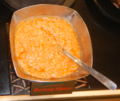
|
Philippines | A Filipino dish consisting of cooked rice and whole raw shrimp fermented with salt and angkak (red yeast rice). |
| Bánh cuốn | 
|
Northern Vietnam[8] | Made from a thin, wide sheet of steamed fermented[9] rice batter filled with seasoned ground pork, minced wood ear mushroom, and minced shallots. |
| Brem | 
|
Indonesia | A traditional fermented food of Indonesia that uses rice. |
| Chakuli pitha | 
|
India | A rice-based fried pancake traditionally made in the Indian state of Odisha. It is made from fermented rice and black gram. |
| Dhokla | 
|
Gujarat, India | A vegetarian food item made with a fermented batter derived from rice and chickpea splits.[10] |
| Dosa | 
|
India | A fermented crepe or pancake made from rice batter and black lentils. It is a staple food in many parts of India. Pictured is rava dosa, a type of dosa. |
| Enduri Pitha | 
|
India | A traditional pitha made in the northern and central region Indian state of Odisha. A fermented batter made of rice and black gram is steamed with/without stuffing made of coconut, jaggery and black pepper. |
| Idli | 
|
Indian subcontinent | A type of savoury rice cake, popular as breakfast foods in Southern India and in Sri Lanka. The cakes are made by steaming a batter consisting of fermented black lentils (de-husked) and rice. |
| Injera | 
|
Ethiopia | A sourdough-risen flatbread with a unique, slightly spongy texture. Traditionally made out of teff flour,[11] it is a national dish in Ethiopia and Eritrea. |
| Kenkey | 
|
Ghana | A fermented maize dumpling. |
| Khanom chin | 
|
Thailand | Fermented rice noodles. |
| Kuzhi paniyaram | 
|
India | Steamed rice and black lentils batter. |
| Mixian (noodle) | 
|
Yunnan Province, China | A type of fermented rice noodle, made from ordinary non-glutinous rice, generally sold fresh rather than dried. |
| Ogi | 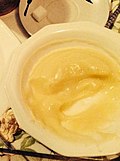
|
Nigeria | A fermented cereal pudding, typically made from maize, sorghum, or millet. |
| Palappam | 
|
South India | A type of pancake made with fermented rice batter and coconut milk. |
| Pesaha Appam | 
|
Kerala, India | A firm rice cake made by the Christians of Kerala, India, to be served on the night of Maundy Thursday (Pesaha). It is made from rice batter like palappam, but is not fermented with yeast in its preparation. |
| Peuyeum, Tapai | 
|
Southeast Asia, East Asia | A traditional fermented preparation of rice or other starchy foods. |
